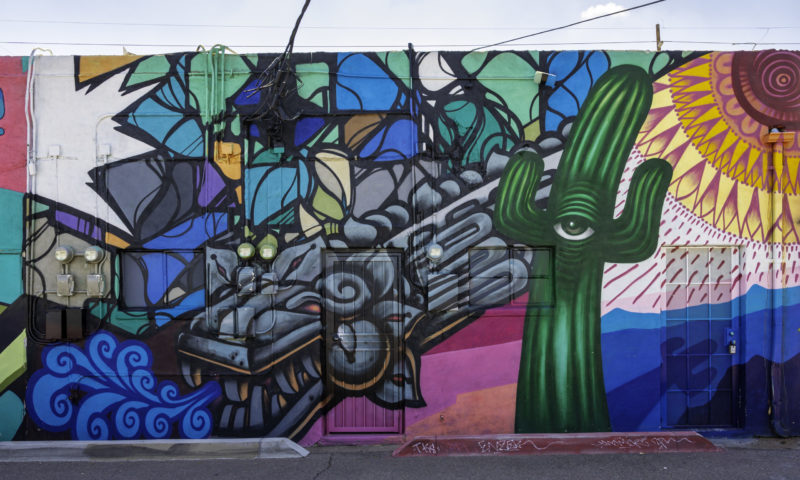
More Art, Please
Find out how the restorative power of art can transform meetings.
As planners begin to embrace the future of meetings, there’s a wide variety of data that underscores aspirations for channeling new sources of inspiration and engagement. A substantial body of research supports the idea that making and viewing art can reduce stress levels and serve as a powerful activity to stimulate the brain.
For meeting planners, an art break can serve as an opportunity for socializing while engaging attendees in ways that help them cut through mental clutter to generate new ideas—ultimately benefiting the organization’s bottom line.
“What I learned is that by engaging my hands in the process of art making, I am able to stop working and stop checking emails, and disengage both physically and mentally,” says Cindy Dach, an artist who owns and operates the MADE Art Boutique and art space in Phoenix’s Roosevelt Row Arts District, as well as two bookstores, called Changing Hands. “It’s not just the peace of mind that I feel when I’m actually doing the art, but also the fact that it actually gives me permission to stop working. And the only way I can be successful at my work is if I step away from it from time to time.”
With expert insight from Dach, who also works to develop Phoenix’s Roosevelt Row as an art destination, here’s a closer look at how art can enhance meetings and how to successfully tap into its benefits at your next gathering.
A Unique Way to Hit the Reset Button
Amid the nonstop daily grind of work and other stimuli, engaging with art provides an essential opportunity to pause and reset. The unending stream of professional and personal demands can feel like running a marathon without ever stopping to drink water, Dach explains. Art can provide the fuel to keep going.
Whether in the form of visual arts, performance or live music, art offers what Dach calls a “counterweight” to the structured, ultra-focused work of meetings and retreats. “It provides the breath, it provides whitespace,” she says. “It allows our five senses to respond in a whole different way.”
Why It Works
Having an opportunity for a pause at meetings isn’t just a break from the work of the day, it’s an essential component. When we’re just moving forward to get through the end of each busy day, to cross off the items on our to-do lists, we don’t give ourselves the time or space to evaluate the big picture and strategize for the future. It’s micro-level tasks without macro-level thinking.
“Art shifts our brain so that we can re-engage in a new way,” Dach says. “It allows us that time and space to take a step back. It not only feeds our soul, it also makes us smarter because it allows us to use our brain in a different way.”
How to Incorporate Art at Your Next Meeting
Meetings can incorporate art in any number of ways including a unique venue selection—such as an art gallery or a museum space—or going all-in with an immersive art-making experience. The key, Dach says, is to make whatever you do interactive.
“Ideally it’s not just something in the background at the cocktail hour, but actually a performance with audience participation,” she says. “It can be painting pottery that ends up in a fundraiser, or some other way to get their hands dirty.” At the end of the day, you want something that’s fun and memorable for attendees.
Dach has indelible memories from one event at which she participated in a candle-making experience as part of an evening reception. “What was so interesting was the way the participants of the conference engaged with each other during the candle making,” she says. “That hands-on activity changed our brains and we started discussing takeaway experiences for our own businesses.”
Extra Benefits
As a known stress reliever, art can play a critical role in a work landscape upended by the pandemic. “Our world is dealing with a whole new level of stress,” Dach says. “And when we’re stressed, we can’t listen and we can’t engage, because our brains are just in such high gear.” When attendees are too tightly wound, they can’t generate new ideas or output productivity that contributes to the bottom line.
“Working harder doesn’t always mean working smarter,” Dach says. “Art is something that can gently regenerate us, as we engage our brains and bodies in a different way that will reduce stress.”
And when this happens, attendees participate more intentionally, think more critically, and find the inspiration that leads to better outcomes. “It’s like changing the temperature of the room,” she says. “Sometimes you’re in a room so hot, everybody gets sleepy, or you’re in a room so cold that everybody’s putting on sweaters. You need to change the temperature so that people can engage differently, and that’s what engagement with art does.”
The Ultimate Itinerary for Art in Phoenix
Check out the Roosevelt Row Arts District (located just over a half mile from the Phoenix Convention Center) for unique venues and experiences:
- The Lost Leaf, one of Phoenix’s oldest bars, features a gallery and live music nightly.
- Modified Arts and MonOrchid galleries offer immersive art experiences.
- Greenwood Brewery has multiple event spaces and is the only woman-owned brewery in Arizona (under the same roof as Made Art Boutique).
- The Churchill is a must-see community space built out of shipping containers, offering food, beverage, retail and a mural alley around back.
- Cahokia SocialTech + ArtSpace, an indigenous-led social, tech and art working space, is home to gallery, exhibit and retail areas, as well as workshops, markets, and events.
- Named one of the top jazz venues in the United States by DownBeat magazine, The Nash is just one of the area’s many staged venues.
- Cambria Hotel Downtown Phoenix Convention Center and Found:RE Phoenix are two downtown properties that infuse their spaces with art installations and rotating exhibits.
To find out how Visit Phoenix can help you plan your next art-infused event, visit visitphoenix.com/meetings.





